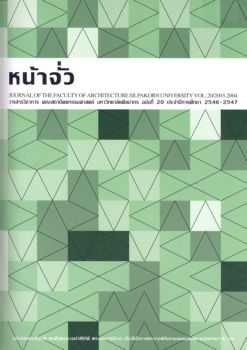การสํารวจมรดกทางวัฒนธรรมในกรุงรัตนโกสินทร์ชั้นนอก
คำสำคัญ:
มรดกทางวัฒนธรรม, การอนุรักษ์แบบบูรณาการ, เมืองประวัติศาสตร์ที่มีการใช้งาน, Cultural heritage, Integrated conservation, Living ancient cityบทคัดย่อ
เมื่อเอ่ยถึงกรุงรัตนโกสินทร์ ผู้คนส่วนมากมักนึกถึงวัดพระศรีรัตนศาสดาราม พระบรมมหาราชวัง และท้องสนามหลวง โดยนึกไม่ถึงว่าย่านบางลําพู ถนนราชดําเนิน เสาชิงช้า พาหุรัด และอื่นๆ ก็เป็นส่วนหนึ่งที่สําคัญของเมืองหลวงเก่าแก่นี้ ซึ่งเป็นแหล่งสั่งสมมรดกทางวัฒนธรรมของชุมชนที่ตั้งรกรากมานานกว่าสองศตวรรษ ตั้งแต่เริ่มสร้างกรุง
กรุงรัตนโกสินทร์ยุคแรกๆ เป็นสถานที่ที่ผู้คนหลากหลายเชื้อชาติศาสนา ทั้งข้าทาสบริวารและพวกที่อพยพมาจากต่างแดนพากันเข้ามาตั้งหลักแหล่ง จึงอุดมไปด้วยมรดกทางวัฒนธรรมซึ่งผสมผสานกันอย่างน่าสนใจ ทั้งวัฒนธรรมที่จับต้องได้ เช่น ปราสาทราชวัง วัดวาอาราม อาคารบ้านเรือน ฯลฯ และวัฒนธรรมที่จับต้องไม่ได้ เช่น ประเพณี และวิถีการดํารงชีวิต เป็นต้น น่าเสียดายที่มรดกทางวัฒนธรรมเหล่านี้กําลังค่อยๆ สูญหายไปจากสังคมปัจจุบัน โดยเฉพาะชุมชนที่มีเอกลักษณ์เด่นและชุมชนซึ่งสืบทอดกันมายาวนาน ทั้งนี้ เพราะขาดการศึกษาค้นคว้าและขาดความตระหนักในคุณค่าของชุมชนเก่าแก่
บทความนี้เป็นการถ่ายทอดรายงานการสํารวจแหล่งมรดกทางวัฒนธรรมในกรุงรัตนโกสินทร์ ซึ่งนักศึกษาจํานวนหนึ่งของคณะสถาปัตยกรรมศาสตร์ มหาวิทยาลัยศิลปากร ได้ศึกษาไว้เป็นข้อมูลเบื้องต้น เป็นการช่วยขยายความรู้ความเข้าใจในสิ่งที่สาธารณชนทั่วไปไม่ค่อยมีโอกาสรับรู้มาก่อน การสํารวจเมื่อปี พ.ศ. 2546 โดยคณะนักศึกษาได้แบ่งการสํารวจเป็นกลุ่มย่อยตามพื้นที่แขวงการปกครอง จำนวน 8 แขวง ซึ่งขึ้นกับเขตพระนคร ข้อมูลในแต่ละแขวงได้แสดงประวัติโดยย่อของการตั้งถิ่นฐานของชุมชน อาคารสถานที่สําคัญๆ และสภาพแวดล้อมทางวัฒนธรรมที่สมควรได้รับการอนุรักษ์ นอกจากนี้ผู้เขียนยังแทรกประเด็นวิเคราะห์ซึ่งอาจเป็นประโยชน์ต่อการศึกษาในเบื้องลึกไว้ด้วย
A Survey of Cultural Heritage in the Outer Rattanakosin Area
When the word Rattanakosin comes to mind, most people would refer to the Grand Palace, Temple of Emerald Buddha, Sanam Luang, and a few more touristspots in the heart of Old Bangkok - - not many would also include places like Bang Lampoo, Ratchadamnoen Avenue, Brahman's Giant Swing, bustling Pahuratretails node, and some other areas within its periphery despite the fact that these settlements have emerged since the inception of this living historic city.
Early residents of Old Bangkok consisted of a wide variety of ethnic groups such as Chinese, Indian, Mon, Laotian, Burmese, Cambodian, Vietnamese, Malaysian, Portuguese, etc. Most of whom were either prisoners of war or fled from neighboring countries. Cross-cultural activities have since then been flourished and become the nature of Bangkok lifestyle. During the past two centuries, tangible heritage as well as intangible one were created and passed on from one generation to another. However, due to lack of adequate public awareness and concern, loss of certain heritage in many settlements started to be felt. The editoris afraid that unless in-depth studies and preservation efforts are introduced soonest possible, safeguarding cultural environment of this historic city would become too late.
This paper has been edited from a field survey of cultural heritage conducted by a number of architecturalstudents ofSilpakorn Universityinthesummer of2003. Itis meantforuseasan introduction to the areas less known to the public in order to help secure awareness in the protection of heritage at risk. The survey was carried outineightsub-areas which coincide with the existing political boundaries. A brief note of history is provided along with the lists of valuable buildings/places/ways of life foundin each sub-area. The editor also added his comments wherever appropriate as earmarks for further studies/investigations.





